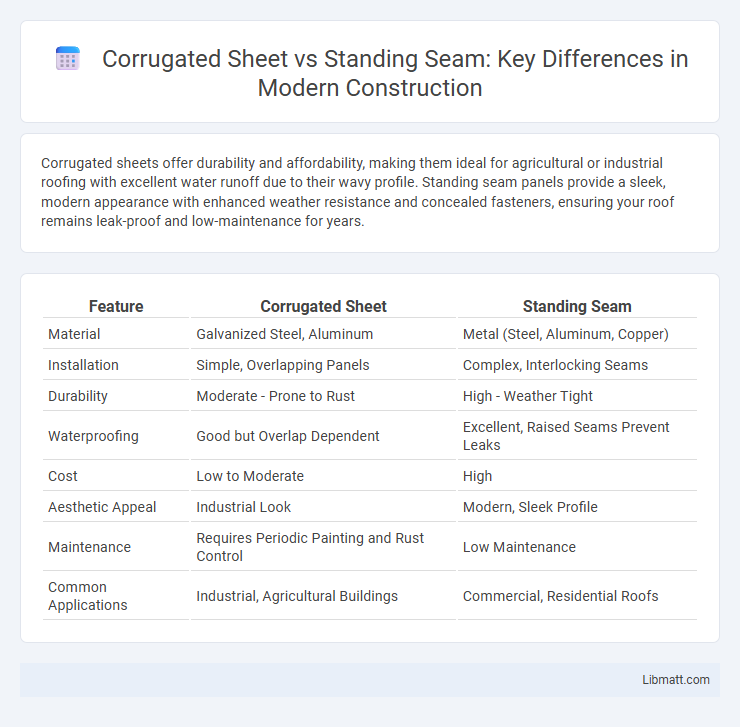Corrugated sheets offer durability and affordability, making them ideal for agricultural or industrial roofing with excellent water runoff due to their wavy profile. Standing seam panels provide a sleek, modern appearance with enhanced weather resistance and concealed fasteners, ensuring your roof remains leak-proof and low-maintenance for years.
Table of Comparison
| Feature | Corrugated Sheet | Standing Seam |
|---|---|---|
| Material | Galvanized Steel, Aluminum | Metal (Steel, Aluminum, Copper) |
| Installation | Simple, Overlapping Panels | Complex, Interlocking Seams |
| Durability | Moderate - Prone to Rust | High - Weather Tight |
| Waterproofing | Good but Overlap Dependent | Excellent, Raised Seams Prevent Leaks |
| Cost | Low to Moderate | High |
| Aesthetic Appeal | Industrial Look | Modern, Sleek Profile |
| Maintenance | Requires Periodic Painting and Rust Control | Low Maintenance |
| Common Applications | Industrial, Agricultural Buildings | Commercial, Residential Roofs |
Introduction to Roofing Systems
Corrugated sheets and standing seam roofing systems offer distinct advantages for different construction needs. Corrugated sheets feature a wavy, repetitive pattern that provides durability, cost-effectiveness, and ease of installation, making them ideal for industrial and agricultural buildings. Standing seam roofs have raised seams that interlock securely, offering superior weather resistance, longevity, and a sleek aesthetic, which enhances your building's overall protection and energy efficiency.
What is Corrugated Sheet Roofing?
Corrugated sheet roofing consists of metal sheets shaped into repetitive ridges and grooves, providing enhanced strength and durability for various building applications. This type of roofing is lightweight, cost-effective, and resistant to weather elements, making it a popular choice for both residential and industrial structures. Your decision between corrugated sheet and standing seam roofing depends on factors like aesthetic preference, installation complexity, and long-term maintenance needs.
What is Standing Seam Roofing?
Standing seam roofing features vertical metal panels with raised seams that interlock, providing superior weather resistance compared to corrugated sheets. This roofing system uses concealed fasteners, enhancing durability and creating a sleek, modern aesthetic. Its design minimizes leakage by channeling water away from the seams, making it ideal for long-term, low-maintenance applications.
Materials and Durability Comparison
Corrugated sheets, commonly made from galvanized steel or aluminum, offer lightweight durability and resistance to weather, making them ideal for budget-friendly roofing with moderate lifespan. Standing seam panels, crafted from high-grade metals like zinc, copper, or coated steel, provide superior corrosion resistance and exceptional longevity, often exceeding 50 years with minimal maintenance. Your choice between these materials influences roof durability, cost, and long-term performance, with standing seam delivering higher resilience and aesthetic appeal.
Installation Process: Corrugated vs Standing Seam
Corrugated sheet installation involves straightforward overlapping panels secured with screws, making it quicker and more cost-effective for DIY projects or large surfaces. Standing seam requires precise alignment of interlocking metal panels fastened with concealed clips, ensuring superior weather resistance but demanding professional expertise and longer installation time. Your choice depends on the balance between ease of installation and enhanced durability provided by the standing seam system.
Weather Resistance and Leak Protection
Corrugated sheets offer excellent weather resistance through their wavy design, which promotes efficient water runoff and reduces the risk of water pooling. Standing seam roofing provides superior leak protection with raised seams that interlock tightly, preventing water infiltration even during heavy rainfall or snow. The seamless connections of standing seam systems ensure enhanced durability against harsh weather compared to the exposed fasteners found in corrugated sheets.
Aesthetic Appeal and Design Flexibility
Corrugated sheets provide a classic, industrial look with repetitive ridges that enhance structural strength but offer limited design variety. Standing seam roofing features sleek, raised seams that create a modern, clean appearance and allow for expanded design customization, including curved and expansive installations. Both materials vary in aesthetic appeal, with standing seam preferred for architectural projects emphasizing contemporary style and corrugated sheets favored for functional, cost-effective applications.
Cost Analysis: Upfront and Long-Term
Corrugated sheets typically offer a lower upfront cost compared to standing seam roofing, making them a budget-friendly choice for initial installation. However, standing seam roofs, with their durable interlocking panels and superior weather resistance, often provide greater long-term value by reducing maintenance and replacement expenses. Evaluating your project's lifespan and maintenance budget is essential to determine which roofing system delivers the best cost efficiency over time.
Maintenance Requirements and Lifespan
Corrugated sheets offer low maintenance with occasional cleaning and rust prevention but typically have a shorter lifespan of 20-30 years due to their thinner material and exposure to weather elements. Standing seam metal roofs require minimal maintenance, mainly periodic inspections and sealant checks, and boast a longer lifespan of 40-70 years thanks to their interlocking design and durable materials like aluminum or galvanized steel. The superior durability and low upkeep of standing seam roofing make it a preferred choice for long-term roofing solutions compared to corrugated sheets.
Choosing the Right Roofing Option for Your Project
Corrugated sheet roofing offers cost-effective durability with excellent water drainage, making it ideal for agricultural and industrial buildings, while standing seam roofing provides superior weather resistance and a sleek, modern appearance suited for commercial and residential projects. You should consider factors like budget, aesthetic preferences, and long-term maintenance when choosing between the two, as standing seam typically requires less upkeep but comes with a higher initial investment. Evaluating your project's climate conditions and architectural style ensures the selected roofing material meets performance and design expectations.
Corrugated sheet vs standing seam Infographic

 libmatt.com
libmatt.com